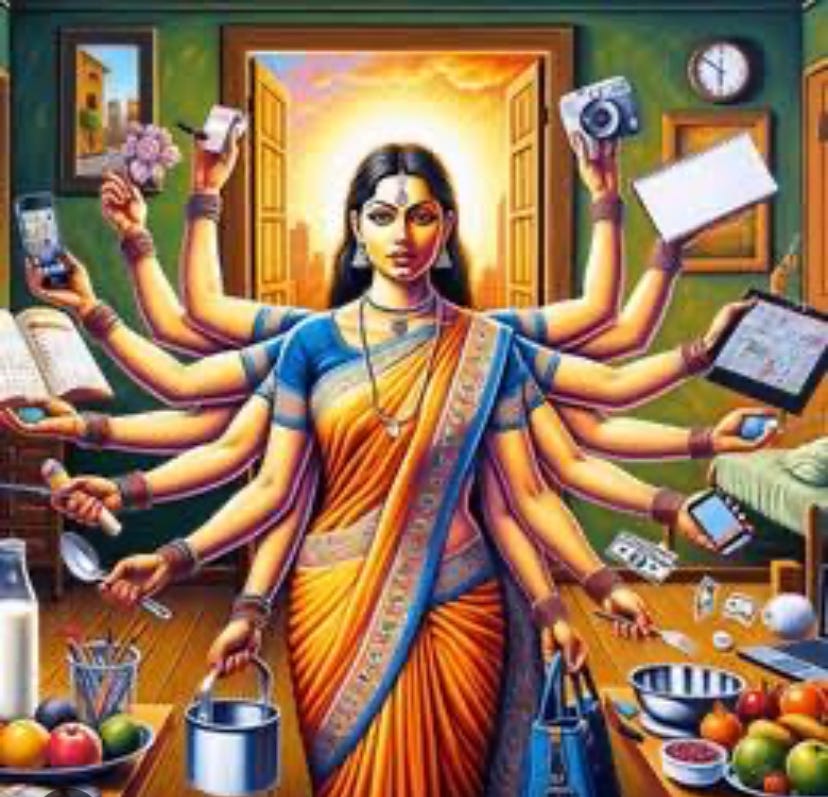Some context: Today is the last day of Dussehra, a ten-day Hindu festival celebrated variously across the many states and cultures of India. Goddess Durga is the protagonist in some of these variations, the victor of good over evil.
Come Dussehra, WhatsApp groups get inundated with pictures of Goddess Durga and her 10 (or 15 or 20) hands, accompanied by messages spouting how all of womankind is the Goddess, capable of juggling a plethora of responsibilities ranging from spouse to parents-in-law to children to work to kitchen to exams to… ok am out of breath.
Regular readers of Girl At Work (GAW) will remember I have referenced this image of the multi-handed, multi-tasking woman less than charitably here and here.
What really is your problem, I can hear some of you muttering. Isn’t that a good thing, to laud the woman as the conqueror of all problems, vanquisher of evil, while also cooking hot dinner every night for her loved ones?
Read that question again. The problem is lying in there, rather all over it.
Many decades back, when women started claiming financial independence, they joined the paid workforce at a huge cost. Many of them first generation salaried-job-holders, they were deeply conditioned to remember that keeping the household together was their primary job, everything else verily dispensable. Even if they didn’t want to, that’s a part of the bargain they had to keep just to be able to get out and earn an honest day’s salary - the household shouldn’t suffer because of their “desires”.
A lot of us are familiar with stories about how mothers woke up at 5am, cooked for the entire family, packed everyone’s lunch boxes lovingly (sometimes in frustration too?), dropped their kids to school / school bus and caught public transport to work, only to come back in the evening, ready to start their second shift to make evening dinner and tuck everyone into bed ever so lovingly.
These stories are proud artefacts at many dinner tables. Yes, it is important to acknowledge them for what they are, valuable and precious, from a time when the fight was harder, the path more strenuous.
We aren’t in those times now in many parts of this country, and that’s a good problem to have.
We are in times where both spouses holding paid jobs is more normal than it was in the 1980s. Now that it is no longer a novelty, now that in many households women aren’t first generation salaried-job-holders, load-sharing between the spouses, hiring helpers, outsourcing tasks, leveraging machines and letting go of some things (like making fresh rotis for every meal) should be normal too. Which means women should ideally not be multi-tasking so much as they were (implicitly or otherwise) forced to, in the ‘80s and ‘90s.
So, what value do those multi-tasking Durga images add today? Are they really glorifying women or still implicitly pressuring them to deliver on all counts, gently goading them into it with nothing but some WhatsApp plaudits in return?
I wonder for myself - Do I want better load balancing of my work and life so I can redeem some sanity or do I want to win some messages for being a valiant, all-doing Goddess?
The former any day. Remember, the latter is not about all-having but all-doing. And there’s a world of a difference between the two.
So, next time you come across a multi tasking goddess being touted as the best thing since sliced bread, pause and think - Does that make sense for the Goddess?
P. S. Views strictly personal. None of the events mentioned in this post refer to the organisation that I am currently associated with.




Totally agree with your take on the multi-tasking goddess narrative people love. Worth noting that there are gods with multiple hands too. And all of the hands of Durga actually hold weapons. Not a single one is a domestic appliance.